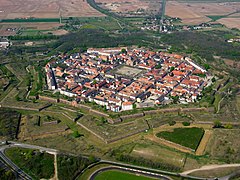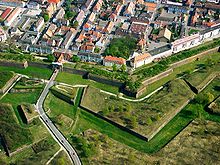Neuf-Brisach
| Neuf-Brisach | ||
|---|---|---|

|
|
|
| region | Grand Est | |
| Department | Haut-Rhin | |
| Arrondissement | Colmar-Ribeauvillé | |
| Canton | Ensisheim | |
| Community association | Pays Rhin-Brisach | |
| Coordinates | 48 ° 1 ' N , 7 ° 32' E | |
| height | 194-198 m | |
| surface | 1.33 km 2 | |
| Residents | 1,931 (January 1, 2017) | |
| Population density | 1,452 inhabitants / km 2 | |
| Post Code | 68600 | |
| INSEE code | 68231 | |
| Website | www.neuf-brisach.fr | |
Neuf-Brisach (German Neubreisach , Alsatian (Nei-) Brisach ) is a French commune with 1931 inhabitants (as of January 1, 2017) in the Haut-Rhin department in the Grand Est region (until 2015 Alsace ). She is a member of the Pays Rhin-Brisach community association .
The city was built at the beginning of the 18th century by the fortress builder Prestre de Vauban together with his genius director Jacques Tarade , who laid it out as a planned city in the form of an octagon with a central parade ground, which is now used as a marketplace, and a checkerboard road network as the ideal form of a fortress city . In the city there was accommodation for the soldiers and officers, supply facilities, a church, houses for non-military residents of the various classes, as well as an impressive system of walls, trenches and gates around the city.
Since the city was laid out on the plain, it was possible to implement the ideal form of the fortress construction. The city complex was thus representative of the military architecture of the Baroque , when many fortified cities were laid out on the French borders under Louis XIV (see also Saarlouis ).
location
The city is located in the Upper Rhine Plain about three kilometers west of the Rhine canal and the Rhine , which is the border between France and Germany , opposite the city of Breisach . The distance to Colmar to the west is around 15 km. The urban area is almost completely surrounded by the municipality of Volgelsheim , in the west the place Wolfgantzen borders on Neuf-Brisach. The Rhine-Rhône Canal runs east of the fortifications and has lost its importance on this section of the route due to the Rhine canal .
history
After the heavily fortified Breisach, like the neighboring Alsace, was annexed by France in the 17th century, it had to be returned to Austria in 1697 after the Peace of Rijswijk . A new border fortification on the Rhine was necessary for France. Louis XIV, the Sun King , therefore commissioned his fortress architect Vauban to build a counter-fortress to the German imperial fortress of Breisach. From 1699 to 1703 he built what was then the largest fortification system based on the model of a baroque drawing board settlement . The building material was brought from the Vosges on the specially built canal Canal de Rouffach (today: Canal Vauban ) . The church was only built in 1736 and the town hall in 1758 after a temporary structure was demolished.
In 1743 the fortress resisted an attack by the Austrians. After this event, the city played no role in European history, not even regional history, until 1870. During the Franco-Prussian War , Neuf-Brisach and its 5,500-strong garrison were besieged by German troops from the 4th Reserve Division (approx. 15,000 men) under General Wilhelm von Schmeling . The siege lasted from October 7 to November 10, 1870 and ended with the surrender by the French commander Lieutenant-colonel de Kerhor, 4,700 men and 100 officers were transferred into German captivity. The city was exposed to nine days of artillery fire during the siege, which caused severe damage. Of 280 buildings, 60 were completely destroyed, 70 heavily and 135 partially damaged, only 15 buildings remained intact. The fortifications were - with the exception of the bastion towers 3 and 5 as well as the Strasbourg and Colmar Gate, which were each severely damaged - only slightly damaged. During the bombing, the civilian population found shelter in the casemates , so that “no man, woman and child was killed or wounded”.
The city was later rebuilt, but the complex remained militarily insignificant. A railway line was broken through the ramparts. The city, however, narrowed by the fortifications and the garrison with its barracks, had no development opportunities in the following decades. Today it is a community with around 2,000 inhabitants, but economic development takes place in the neighboring communities of Biesheim and Volgelsheim. Since the garrison was dissolved in 1992, Neuf-Brisach has been almost a residential community for commuters to Colmar and the Breisgau .
Today there is a Rhine bridge for road traffic between Breisach and Neuf-Brisach , which was put into operation as a railway bridge in 1878.
Population development
| year | 1790 | 1851 | 1905 | 1936 | 1962 | 1968 | 1975 | 1982 | 1990 | 1999 | 2007 | 2015 |
|---|---|---|---|---|---|---|---|---|---|---|---|---|
| Residents | 1667 | 3893 | 3522 | 2150 | 2127 | 2580 | 2579 | 2205 | 2092 | 2207 | 2397 | 1938 |
| Cassini and INSEE | ||||||||||||
politics
The municipal council consists of the mayor ( Maire ), three councilors and 15 other council members.
Cityscape
The fortress town of Neuf-Brisach is geometrically laid out as a planned town . It corresponds to the so-called bastioned system that Vauban refined and brought to its peak in Neuf-Brisach. The defense of the facility consists of two walls, a fighting wall, consisting of the gently rising fore area, the glacis with the covered path for the infantry, as well as various outer works with artillery (counter-guards, crescent moons, pincer works), a security wall, hidden behind the fighting mechanisms , consisting of eight bastion towers and the intermediate walls. The bastion towers, as keys to close defenses, are covered by the counter-guards against fire. The guns of the battle wall line the apron in front of the glacis. The glacis itself is defended with infantry weapons. The enemy can only reach the security wall after taking the battle wall. Since this cannot be destroyed from the outside, the attacker is faced with an undamaged defense system. Each bastioned tower defends the two neighboring towers and is defended by them. Each tower has four guns on a terrace and four other guns in casemates. The intermediate wall is broken or detached in order to enable four additional guns, two on top of the wall and two in casemates to defend the bastion front (section of the wall between two bastion towers).
Neuf-Brisach was laid out as an octagon with a bastion tower at each tip. 20 posterns (passages through the wall) and four grand gates allow troops to move quickly. The modern fortress is low in order to offer as little attack surface as possible. In contrast to medieval castles, which were often built on inaccessible heights, the modern fortresses were placed on the main roads. The infantry could bypass the fortresses, but not their entourage . A heavy cannon weighed at least two tons. A battery of ten 24-pounders fired twelve tons of bullets and six tons of powder in one day. Solid roads were required to transport this military equipment. In addition, two cavalry regiments were stationed in the city in order to disrupt an extensive bypass.
The streets are arranged at right angles around a square, the Place d'Armes. The central square, two by two blocks in size, has been left free as a parade and roll call area. The blocks of houses (50 x 50 m) are the same size. Everything in this small town, even the church, is subordinate to military purposes. The former market square with the town hall is located on the edge of the Place d'Armes. Four gates are located on the four streets leading from Place d'Armes. The barracks were located around the center, protected by the ramparts.
Attractions
- The fortifications, along with other works throughout France, have been part of the UNESCO World Heritage Site " Fortifications of Vauban " since 2008 .
- In addition to the fortifications and the preserved urban structure, there is a Vauban Museum in the Belfort Gate, which provides information on the history of the city's construction.
- The “royal” town church of St. Louis from 1777 was consecrated on October 5, 1975 after its reconstruction.
- The Musée Arts Urbains et du Street Art, known as Mausa for short, opened another museum in the casemates in summer 2018.
Partnerships
Neuf-Brisach has had a partnership with the French community of Meilhan-sur-Garonne in Aquitaine since 1988. This partnership goes back to the evacuation of residents of Neuf-Brisach in 1939, which, as in many Alsatian communities, took place out of fear of a German invasion.
Since 2000 there has been a partnership with the neighboring German sister city of Breisach am Rhein . Curiously, both cities take the name Br (e) isach for themselves. The Alsatians usually only refer to Neuf-Brisach as Brisach in contrast to the German Vieux Brisach (or Alsatian / Alemannic Altbrisach ), while the German side holds it almost the other way around with the distinction between Breisach / Neubreisach.
Personalities
- François-Joseph d'Offenstein (1760–1837) French general of the coalition wars, 1793/94 commander of the city of Neuf-Brisach
- Ernst Hugo Correll (1882–1942), German film producer, born in Neuf-Brisach
- Quirin Engasser (1907–1990), German writer, born in Neuf-Brisach
- Pete Wyoming Bender (1943–2014), American singer and composer of Indian descent, born in Neuf-Brisach
proof
- ^ Paul Wolff: History of the bombing of Schlettstadt and Neu-Breisach in 1870 . F.Schneider, Berlin 1874, pp. 60–70.
- ^ Franz Brockhoff: History of the city and fortress Neubreisach in Alsace . Neubreisach 1903. (Repr. {Nachdr.} Freiburg 2000), p. 230.
- ↑ Street Art in the Casemates of Neuf-Brisach , Dietrich Röschmann, Badische Zeitung, November 16, 2018, accessed on July 8, 2019
literature
- Le Patrimoine des Communes du Haut-Rhin. Flohic Editions, Volume 2, Paris 1998, ISBN 2-84234-036-1 , pp. 929-943.
- BALLIET (JM) - Neuf-Brisach 1698 to 1870. From Vauban's masterpiece to an unknown fortress. Regensburg, 2011. In: Fortress architecture in the center of Europe, 2011, no. Fortress Research vol. 3.
- BALLIET (JM) - Water and fortifications using the example of Strasbourg and Neu-Breisach. Sl, 2008. In: Writings of the German Water Historical Society (DWhG) e. V., 2008, No. 10.







